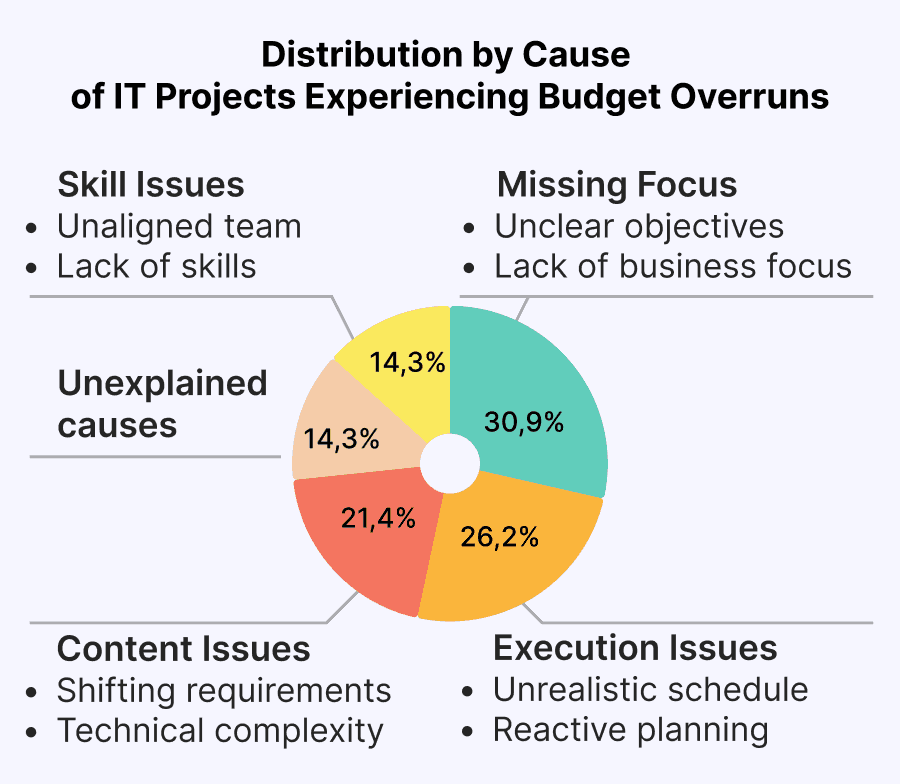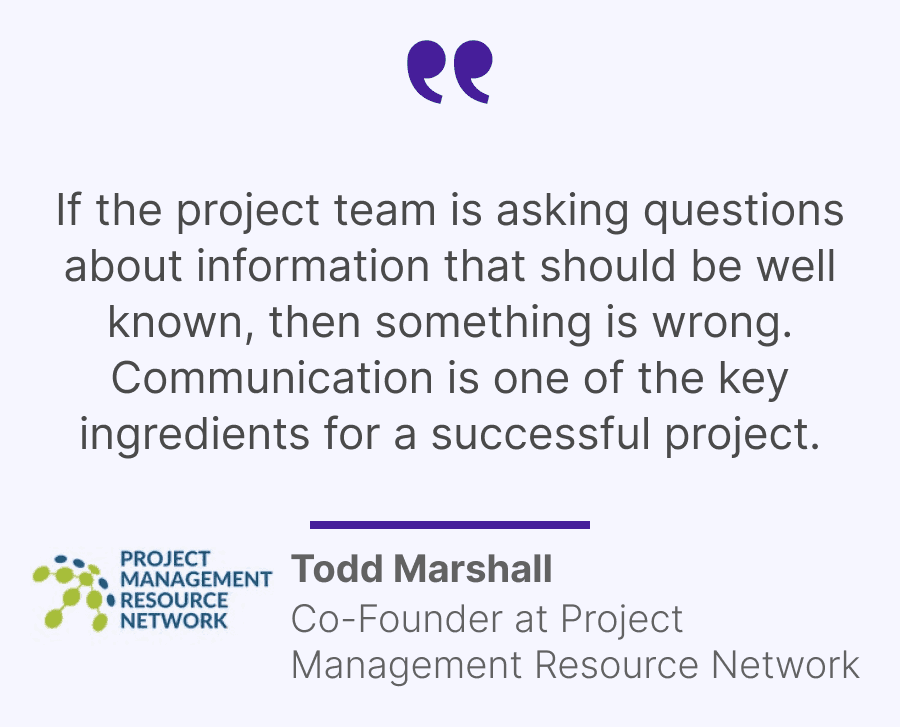How to Rescue a Failing Software Project?
Topic: Guides

February 14, 2024
Software projects fail more often than we'd like to admit. According to research from McKinsey, only 29% of IT projects are successful based on time, budget and requirements criteria. For app owners, product owners, and other business stakeholders, a failing software project can be frustrating and costly.
This article provides a guide for non-technical professionals on how to rescue a failing software project. We'll examine:
- The leading causes of software failures
- Strategies for diagnosing issues
- Best practices for course correction
By adopting the appropriate strategy, it's possible for many troubled projects to start getting back on track towards successful delivery. The aim is to equip readers with practical methods to transform a high-risk, low-velocity initiative into one that meets business objectives.
Problem Identification
A software project can be considered failing or at high risk of failure when it significantly deviates from core planning elements - including timeline, budget, resources, requirements, quality, and value goals - with no clear resolution in sight.
What Are the Signs That a Software Project Is in Crisis and Needs Rescuing?
A software project rescue is needed when there are clear indicators that delivery is at serious risk. Signs of trouble include:
- Major timeline delays - missed deadlines and milestones
- Budget overruns
- Scope creep beyond original requirements
- Quality issues and software defects
- Low team morale and burnout
But how can one distinguish "normal" difficulties from critical problems requiring intervention?
Some challenges are expected on complex projects. But crisis mode is triggered when problems persist without resolution, multiply across areas, or greatly jeopardize business goals.
What Are Common Mistakes That Lead to the Need for Project Rescue?
According to McKinsey surveys of IT executives, 4 groups of issues cause most project failures, with project management mistakes playing a significant role.

These root causes often compound each other. For example, unclear objectives lead to shifting requirements, while technical debt drives complexity that derails planning. Awareness of these common pitfalls can help identify problems early and avoid spiraling project failure.
Situation Analysis
How to Conduct an In-Depth Analysis of the Causes of Problems in the Project?
Getting to the bottom of issues requires investigating from multiple angles:
- Talk to your team and stakeholders. Have open conversations to hear different views on what's going wrong. Ask about their concerns, frustrations, and suggestions for clear communication with developers and to identify any communication gaps.
- Review existing documents and reports. Look for clues in plans, budgets, status updates, and results. Check for misalignments between expectations and realities, which could indicate budget overruns or poor requirements gathering.
- Map out how work is done. Visually diagram the end-to-end process. Visually diagram the end-to-end process. Look for roadblocks, duplication, and disconnects that could be signs of feature creep control issues
- Analyze risks. For understanding project risks, identify potential vulnerabilities and estimate their likelihood and level of impact to grasp the business impact of a failing project.
- Consider an independent project audit. Bringing in an external expert to assess what went wrong can provide objective insights. Just be sure to choose someone familiar with your technology stack and industry to offer cost-effective rescue strategies and project turnaround insights.

Gathering metrics, documents and opinions from different sources will provide the facts needed to determine where and why the project is going off course, vital for devising a project recovery plan and getting back on track.
Software Project Rescue Strategies
Here are key areas to focus on for a software project turnaround.
Area of Focus | Project Success Criteria | Action Steps |
|---|---|---|
Strategy and stakeholder engagement |
|
|
Suitable tech and user value |
|
|
Team competence |
|
|
Proven project management practices |
|
|
Tips for Communicating a Project Rescue Plan to Stakeholders
- Be transparent about the issues and risks discovered; it's crucial for the success of crisis management in software projects. Stakeholders will respond better to early warnings than surprises.
- Present assessment findings constructively. Avoid finger pointing and keep focus on solutions, particularly on salvaging project ROI.
- Discuss potential options and tradeoffs. Collaborate on decisions instead of dictating changes.
- Commit to more frequent status updates and visibility. Regaining trust takes consistency.
- Convey that a project recovery plan aims to ensure a quality product that achieves their goals. Frame it as an investment, not an expense.

Minimizing Risks Associated with Software Project Rescue
Attempting to turn around a struggling project introduces new risks and tradeoffs to manage.
Impact on Budget
Bringing in additional expertise and resources may increase costs in the short-term. Strategies to mitigate budget growth include:
- Carefully evaluating the value of each proposed addition to ensure budget control in software development
- Exploring less expensive staffing alternatives like contractors or temporary workers to implement cost-effective rescue strategies
- Negotiating discounts or concessions from vendors to manage budget overruns
Impact on Timeline
Taking time for intensive analysis and planning can further delay delivery. Tactics to minimize timeline slippage include:
- Overlapping diagnosis of issues with implementation of solutions to facilitate agile delivery for an app
- Focusing ruthlessly on the minimum viable product (MVP) scope
- Accelerating processes like requirements gathering and approvals
- Compressing development phases after blueprinting is complete
With deliberate mitigation efforts, budget and timeline increases can be controlled. The larger risk is not attempting a project turnaround when it is clearly needed, which could lead to a significant business impact of failing projects.
Long-term Viability After Project Rescue
A successful project turnaround provides more than just short-term recovery. It lays the foundations for ongoing stability and future enhancement.
After crisis intervention, focus on sustaining momentum. Solidify gains through good management practices, quality assurance, technical excellence and end-user satisfaction tracking. Build in margin to the schedule and budget so pressure doesn’t immediately rebuild. Leverage lessons learned to improve systemic weaknesses.
With diligence, a rescued project can thrive for the long haul. Turnaround sets the stage for sustained value delivery and salvaging project ROI.
Preventing Future Problems
What Lessons Can Be Learned From the Project Problems?
A project rescue provides a wealth of data to shape process improvements, including:
- Understanding what risks were overlooked or underestimated
- Identifying weak points in planning, requirements, staffing, tools, etc.
- Highlighting communication gaps and collaboration breakdowns
- Pinpointing unproductive practices or waste to avoid budget overruns
Thoroughly debriefing setbacks is essential to extract maximum learning value and avoid startup pitfalls.

How to Avoid Similar Problems in the Future?
It is important to turn the lessons learned into concrete changes in processes and practices. For example, are there ways to enhance how requirements are gathered to make them more complete and accurate? Conducting more incremental reviews during development may catch issues earlier. Building a buffer room on timelines, rather than assuming perfect execution, is also wise.
The key is addressing the root causes through preventive measures rather than superficial fixes. This prevention mindset helps avoid major problems happening again down the road.
What Preventive Measures Can Increase the Project’s Resilience?
Proactive resilience measures include:
- Establishing early warning indicators to trigger support, which is part of agile development for rescue
- Maintaining reserves of time, money and personnel to manage budget control in software development
- Simulation modeling of "what-if" scenarios to prepare for understanding project risks
- Monitoring customer satisfaction as a predictive metric to address lack of user adoption
- Institutionalizing processes for continual improvement, which is part of agile delivery for apps
With foresight and discipline, future missteps can be avoided.
Case Study: Rescuing a Failing Kids App Project
Kids Worldwide Edutainment, an international firm, contracted Cyfrania to rebuild their failing mobile game app for children. The Kidiyo app was removed from app stores over policy violations and had major technical issues like outdated web technology, missing documentation and tests, and legacy code and libraries.
Cyfrania performed an intensive project rescue. In the analysis phase, they audited the codebase to identify critical flaws and reviewed the project history to pinpoint breakdowns. For corrective actions, Cyfrania revamped this iOS and Android app using the modern Unity game engine, improved its architecture for better performance and scalability, and added test automation and documentation.
The results were impressive:
- The app became available again in app stores within 1.5 months, demonstrating a successful minimum viable product turnaround
- Delivered revamped app in just 5 months with a small team, showcasing effective agile delivery for apps
- Unblocked evolution toward customer's vision
- Slashed costs for subsequent development, reflecting cost-effective rescue strategy
- Ensured app quality and compliance, which is crucial for the business impact of the failing project
- Created more engaging and appealing gaming process, addressing user experience issues
Through strategic analysis, remediation and redevelopment, the struggling kids app was rescued and transformed into a state-of-the-art product poised for long-term success.
Conclusion
Wrapping up, here are the steps to turn around a failing software project:
- Conduct thorough root cause analysis from multiple angles
- Implement corrective measures focused on strategy, technology, team, and management practices
- Control risks around budget and timeline overruns
- Extract lessons learned and institute preventive processes
- Bring in outside experts when needed for independent audit and advice
How Can an Independent Audit of a Project Be of Help?
It's often reasonable to contact unbiased experts who have a lot of experience in software project rescue, and here's why:
- Fresh eyes from independent experts on your project simplify problem detection, which is essential for crisis management in software projects
- Independent experts are impartial and don't make excuses for mistakes
- Independent consultants don't burn out or feel mentally exhausted from the project
- They are dedicated solely to putting the project back on track, and they're committed to achieving this in the most efficient way possible
To learn more about rescuing failing software projects, read additional resources and reach out to companies like Cyfrania who offer free consultations for troubled initiatives.
With outside expertise, a failing effort can get back on track.
Additional Resources
- Project Rescue Checklist - download for free
- How to Rescue a Major Project or Program in 10 Steps - an article on Gartner
- Delivering large-scale IT projects on time, on budget, and on value - McKinsey's insights
- Achieving success in large, complex software projects - McKinsey's insights
- What are some signs that a software project is in trouble? - a discussion on Quora
- Why good ideas get trapped in the valley of death - and how to rescue them - a TED talk
- My Project FAILED - a brief video on how to handle a project that's not succeeding